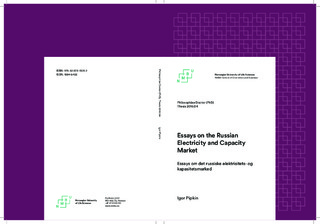| dc.description.abstract | During the past decade the Russian power sector has undergone a dramatic reform. This
has created a need for better understanding of the drivers and development of the sector.
This dissertation describes the functioning of the Russian power market since 2006 by
focusing on price formation, market power and the main regulatory obstacles for
competition.
Paper I focuses on time regularities in Russian power prices and compares these for the
Siberian and the European zones. A set of distinct time regularities is revealed and
discussed: “Day-of-the-week pattern”, “Weekend pattern” and “Time-of-the-day
pattern”. The magnitudes of the price differences and time lag between the zones raise
the question of extending the interconnectors between the zones. The persistence and
magnitude of time regularities in power prices in the European zone imply that
technologies that allow for flexibility, either on the supply or demand side, can be
profitable.
Paper II tests for market power in Northwest Russia using the Bresnahan–Lau
framework by estimating residual demand and supply curves for thermal producers. I
find that price mark-ups are close to 7–8% on average for the hours between 10 am and
9 pm and 2–3% for the remaining hours of the day. The residual demand curve elasticity
is relatively high during peak hours. In addition, demand from Finland/Baltic states and
Center FFZ24 have different profiles, such that total demand is most elastic during peak
hours and least elastic during the periods of rapid change in consumption. The increase
in natural gas prices was reflected directly in electricity prices in Northwest Russia in
the analysed period. The domestic prices for natural gas are expected to increase to the
level of European net-back prices, and given that natural gas will still be the main fuel
in electricity production, this price increase will also be reflected in electricity prices.
The objective of Paper III is to take into account the mathematical formulation of the
Russian power market in the calculation of concentration measures and investigate the
role of transmission constraints using the more detailed framework of the transmission
constrained residual supply index (TCRSI). The analysis supports the previous findings
of high market concentration in the Russian power market, but for different reasons. The
adjusted HHI is below 1400 on average for all price zones and UESs and the adjusted
RSI shows that there exist pivotal generators for more than 5% of hours in the analysed
period only in two of 21 free-flow zones. Nevertheless, the TCRSI reveals that market concentration is critical for most FFZs in Russia in the UC auctions, day-ahead (DAM)
and capacity markets. Market concentration decreases the higher is the share of hydro
producers and transmission capacity to the neighbouring regions in the Russian power
market in general and in addition depends on the share of fixed generation in the DAM.
Paper IV investigates the main challenges and obstacles to competition in the Russian
power market, especially regarding the role of the SO. The transmission constraints
between the European and Siberian zones forced by the SO led to enormous
subsidization of the Siberian zone by customers in the European zone in the DAM. In
addition, must-run generation forced by the system security constraint and demand for
heat affects competition in the capacity market and the UC auctions, which lead to
distortions of DAM. The linear demand curve for capacity by price zone provides
incentives to exert market power, price cap constraints the potential profits of
generators, whereas the lower bound given by the total installed capacity reduces the
incentives for competition.
On the basis of these findings, I present the following policy recommendations:
facilitate consumer response to variation in electricity and capacity prices and invest in
flexible technology on supply or demand side; upgrade the existing transmission
capacity to discourage the exercise of market power and to deal with the supply security
concerns; introduce competitive pricing of heat and fuel (natural gas and coal). | nb_NO |
